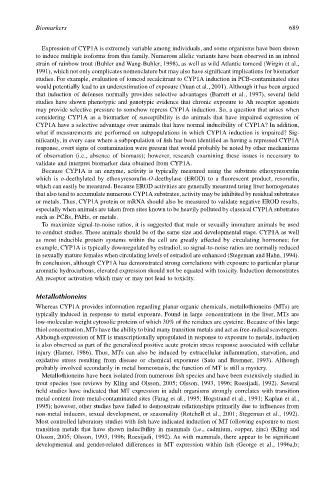Page 709 - The Toxicology of Fishes
P. 709
Biomarkers 689
Expression of CYP1A is extremely variable among individuals, and some organisms have been shown
to induce multiple isoforms from this family. Numerous allelic variants have been observed in an inbred
strain of rainbow trout (Buhler and Wang-Buhler, 1998), as well as wild Atlantic tomcod (Wirgin et al.,
1991), which not only complicates nomenclature but may also have significant implications for biomarker
studies. For example, evaluation of tomcod recalcitrant to CYP1A induction in PCB-contaminated sites
would potentially lead to an underestimation of exposure (Yuan et al., 2001). Although it has been argued
that induction of defenses normally provides selective advantages (Barrett et al., 1997), several field
studies have shown phenotypic and genotypic evidence that chronic exposure to Ah receptor agonists
may provide selective pressure to somehow repress CYP1A induction. So, a question that arises when
considering CYP1A as a biomarker of susceptibility is do animals that have impaired expression of
CYP1A have a selective advantage over animals that have normal inducibility of CYP1A? In addition,
what if measurements are performed on subpopulations in which CYP1A induction is impaired? Sig-
nificantly, in every case where a subpopulation of fish has been identified as having a repressed CYP1A
response, overt signs of contamination were present that would probably be noted by other mechanisms
of observation (i.e., absence of biomass); however, research examining these issues is necessary to
validate and interpret biomarker data obtained from CYP1A.
Because CYP1A is an enzyme, activity is typically measured using the substrate ethoxyresorufin
which is o-deethylated by ethoxyresorufin-O-deethylase (EROD) to a fluorescent product, resorufin,
which can easily be measured. Because EROD activities are generally measured using liver homogenates
that also tend to accumulate numerous CYP1A substrates, activity may be inhibited by residual substrates
or metals. Thus, CYP1A protein or mRNA should also be measured to validate negative EROD results,
especially when animals are taken from sites known to be heavily polluted by classical CYP1A substrates
such as PCBs, PAHs, or metals.
To maximize signal-to-noise ratios, it is suggested that male or sexually immature animals be used
to conduct studies. These animals should be of the same size and developmental stage. CYP1A as well
as most inducible protein systems within the cell are greatly affected by circulating hormones; for
example, CYP1A is typically downregulated by estradiol, so signal-to-noise ratios are normally reduced
in sexually mature females when circulating levels of estradiol are enhanced (Stegeman and Hahn, 1994).
In conclusion, although CYP1A has demonstrated strong correlations with exposure to particular planar
aromatic hydrocarbons, elevated expression should not be equated with toxicity. Induction demonstrates
Ah receptor activation which may or may not lead to toxicity.
Metallothioneins
Whereas CYP1A provides information regarding planar organic chemicals, metallothioneins (MTs) are
typically induced in response to metal exposure. Found in large concentrations in the liver, MTs are
low-molecular-weight cytosolic proteins of which 30% of the residues are cysteine. Because of this large
thiol concentration, MTs have the ability to bind many transition metals and act as free-radical scavengers.
Although expression of MT is transcriptionally upregulated in response to exposure to metals, induction
is also observed as part of the generalized positive acute protein stress response associated with cellular
injury (Hamer, 1986). Thus, MTs can also be induced by extracellular inflammation, starvation, and
oxidative stress resulting from disease or chemical exposures (Sato and Bremner, 1993). Although
probably involved secondarily in metal homeostasis, the function of MT is still a mystery.
Metallothioneins have been isolated from numerous fish species and have been extensively studied in
trout species (see reviews by Kling and Olsson, 2005; Olsson, 1993, 1996; Roesijadi, 1992). Several
field studies have indicated that MT expression in adult organisms strongly correlates with transition
metal content from metal-contaminated sites (Farag et al., 1995; Hogstrand et al., 1991; Kaplan et al.,
1995); however, other studies have failed to demonstrate relationships primarily due to influences from
non-metal inducers, sexual development, or seasonality (Rotchell et al., 2001; Stegeman et al., 1992).
Most controlled laboratory studies with fish have indicated induction of MT following exposure to most
transition metals that have shown inducibility in mammals (i.e., cadmium, copper, zinc) (Kling and
Olsson, 2005; Olsson, 1993, 1996; Roesijadi, 1992). As with mammals, there appear to be significant
developmental and gender-related differences in MT expression within fish (George et al., 1996a,b;

